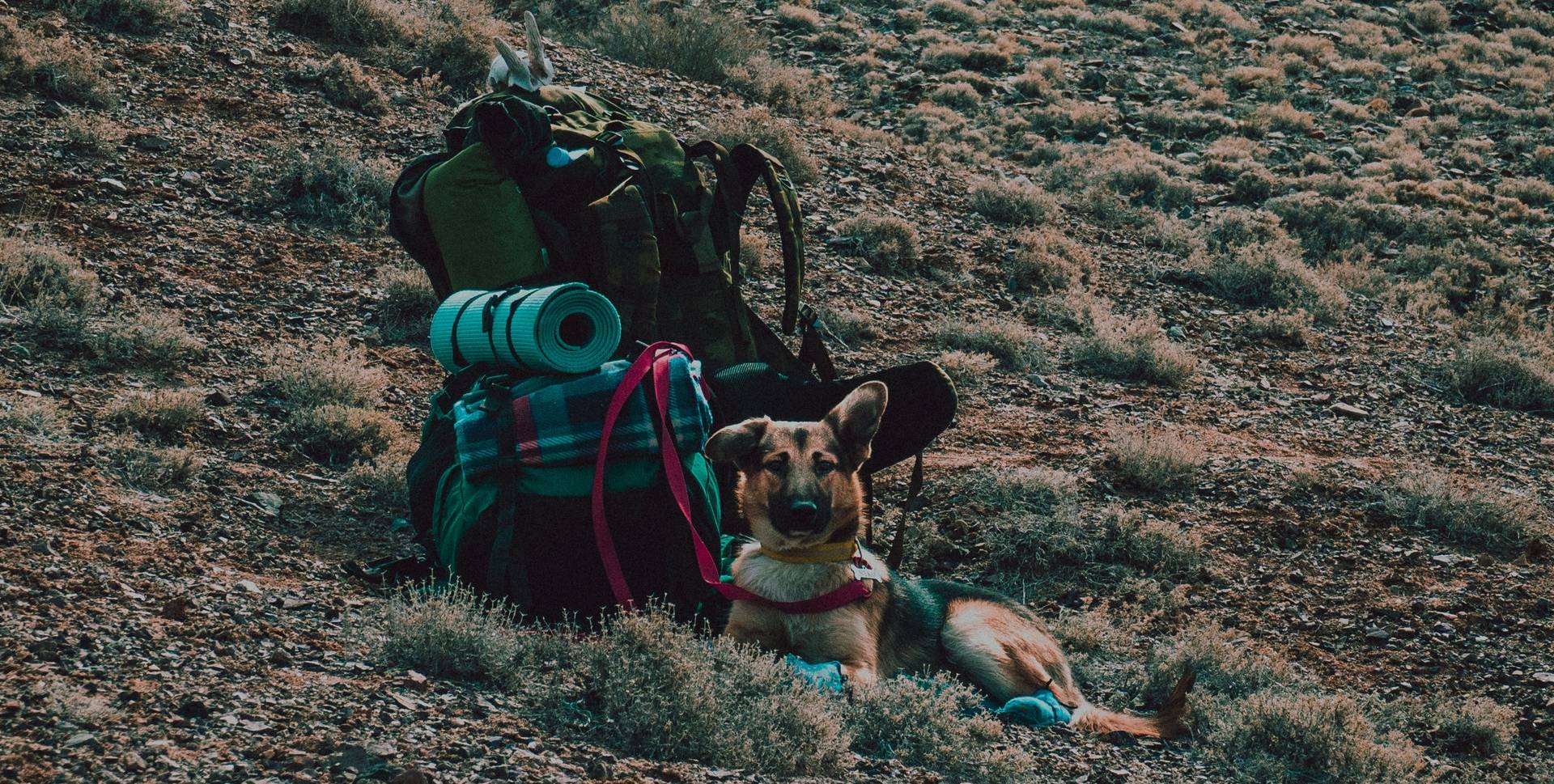
Backpacking and hiking are incredible activities to do with your dog. It allows you to spend time together, get out into nature, and get great exercise. But with this, some concerns may arise. What should I bring for my dog? How will I store their food? Will they be okay on some of the longer trips? How can I make it the best experience possible? I have been there, and it can be stressful trying to plan for these trips with your dog. But this shouldn’t be stressful. That’s why I have made the following guide to help ease the stress and get you and your dog excited for your trip.
So, what food should you pack for your dog, and how should you best pack it? A good rule of thumb is to pack what your dog would usually eat during the duration of the hike, and then increase the calorie intake by at least 50%. This will allow for maximum nutrition and energy for your dog. And of course, pack plenty of water for your pup. If there isn’t room in your pack for your dog’s supplies, you can even find dog saddlebags such as this one, so that backpacking is easier for you and your pup.
If you want more ideas of what to pack for your dog or how to make it the best trip possible, keep reading. We will discuss how to plan for the hike, supplies that make the hike easier for your dog, food ideas, treat ideas, and how to best experience the trail with your pup. Planning is an incredibly important step in this process, as it will allow for the best experience for you and your furry friend.
Planning the Trip
When planning your dog’s food needs for the next backpacking trip, there are several things to keep in mind. One main concern is how much to pack for your dog. Backpacking brings the unique concern of wanting to pack enough food while not overpacking, as every ounce counts. You’ll want to account for the following things.
- days of trip
- daily mileage
- daily calorie intake of dog
- energy level of dog
- health/stature of dog
- expected weather of trail
- terrain of trail
- whether your dog will be on or off-leash

When taking these things into account you will discover what your dog will need. The longer the trip, the rougher the weather, the stability of the terrain; these things will all affect how much you need to increase your dog’s calorie intake (which we will discuss later). If your dog is off-leash then you’ll need to increase your dog’s daily calorie intake by closer to 100% because your dog will be covering much more ground.
You may not know exactly how many calories your dog may be eating during the day, but either way, the amount of food you feed them should be increased. Although, this isn’t always the most efficient way to get your dog more calories. There are ways to increase calories without having to increase the amount of food. This is the preferable way, as every ounce counts when backpacking. You’ll want high-calorie, low-weight foods.
Vets can always be consulted when planning for your backpacking trip. They will often know your dog’s precise calorie intake and exercise levels. But, this article can act as a base guide to help you to know what to pack for your dog throughout your trip.
Food
When planning food for your dog, you’ll want to try to stay as close to what they normally eat as possible. If you make any changes to their diet you’ll want to enforce those several weeks before the hike. You can slowly transfer over to new food by mixing their old food with their new food. This prevents any digestion or stomachache issues for your dog. They definitely won’t want to be dealing with those on the backpacking trip.
Kibble
| Pros | Cons |
| Cheaper than dehydrated or freeze-dried | Heavy and bulky |
While kibble can be bulky and heavy, it can be a great and simple way to get them the calories they need. But, because kibble doesn’t have as much concentrated nutrition, it is suggested that you mix 20% puppy food into the kibble to boost the calorie content. This will help to sustain them during the trip.
Another way to bulk-up the calorie contents of kibble is to add a meat meal topper to the kibble. You can find them either dehydrated or freeze-dried. Stella and Chewy’s makes a great freeze-dried topper that can give your dog more calories to burn while they are hiking and playing. And the protein of the meat will help their muscles to recover quickly from their playing. Kibble can also be a great bonus snack to keep them going on the trail.

One thing to watch out for with kibble is that many of the cheaper brands of kibble are highly processed, so they might not have the needed nutrients to sustain your dog for extended activity. Some of the higher quality kibbles may be more expensive, but they often weigh less. They can also keep your dog happy and nourished on the trail without having to add so many calorie-rich ingredients to your dog’s meals.
Freeze-Dried Food
| Pros | Cons |
| Extremely good quality | Most expensive option |
| Lightest weight option | |
| Fantastic nutrient value | |
| Calorie count per ounce is relatively high |
Freeze-dried food isn’t only a great way to keep your dog energized, but you as well! While it may be expensive, it would be completely worth it depending on your backpacking plans. Because of the nutrient and calorie-rich food, freeze-dried could be the most efficient and lightweight option to keep you and your dog going on the trail.
Raw vs. Cooked
There are two options when looking at freeze-dried food for dogs. There is cooked freeze-dried food and then raw freeze-dried food. Raw food tends to keep more of the calories and nutrients, as cooking food tends to take some of the calories and nutrients out.
Dehydrated Food
| Pros | Cons |
| Much lighter than kibble | Can taste different than the hydrated form of food because of the dehydrating process |
| Cheaper than freeze-dried | The process can destroy some of the nutritional value |
| Comes in powder so it’s much lighter and easier to pack | Takes a couple of minutes to prepare before digesting |
| Just takes water to dehydrate |

Dehydrated food is another great option to look at when decided what to feed your dog on the trail. Its powder form is much lighter than kibble, which is extremely important when it comes to backpacking. According to Pawtivity, the process of rehydrating the food can take around 5 minutes and the food grows about 3-5 times its size as it starts taking on water. Talk about packing a punch.
Turbo Pup Meal Replacement Bars
A bonus form of food is the incredible Turbo Pup meal replacement bars. These are perfect to pack for your pup on a backpacking trip as a pack of two bars weighs only a little over 4 oz. In this pack, there are a whopping 500 calories. This can act as a great replacement meal for your dog out on the trail. It weighs nearly nothing and can help your pet have the needed nutrients and calories. This source of food can cut the weight of your pack without causing you or your dog to sacrifice.
Dog Food Rolls
Red Barn sells dog food rolls that are a fantastic way to pack dog food if your dog is used to wet food. They provide great nutrients and energy for your dog. You can slice or cube the roll to use as a meal or even a tasty snack while on the trail.
They’re great for backpacking as they don’t take up a lot of room or weight in your pack. When looking at food rolls, there are many flavors and options. It’s important to find one that is full of meat-based protein and healthy calories to best serve your dog.
Treats
While it’s important to have the food needed for your dog, treats, and snacks to feed them along the trail will not only keep them full of energy but will help keep them excited and focused. When looking for the perfect dog treat, look for the following three things.
- A treat the packs easily in a small container
- Won’t add weight or bulk
- A treat that won’t make a mess in your pack
- Must in a sealed bag or container
- A treat that will satisfy your dog’s calorie and nutrition level during the duration of the hike
Following are several dog treats that meet these requirements.
Training Treats
Training treats are the perfect snack for backpacking trips. It’s important to find a lightweight food that will satisfy your dog. Training treats are incredibly small and easily digestible, which makes them even more attractive to backpackers. They’re also incredibly sensible, as they are great for any length of the hike. Whether it spans over multiple days or is under an hour, these treats can help your dog stay fed, excited, and motivated.
Dog Biscuits
Dog biscuits are another fantastic treat for dogs along the trail. Following are some benefits of dog biscuits as your treat of choice.
- Easy to pack
- Great for short or long hikes
- Easily digestible
- High amount of sugar to keep them energized

It’s important to keep track of how many biscuits your dog has eaten and to keep their portions small. Because of the high sugar levels, if they have too many in a short amount of time this could make them sick or crash after the sugar high.
Homemade Energy Bars/Balls
Homemade treats are always fun to make for your furry friends, but especially when you can eat them too. Treats that both you and your pet can eat are perfect for backpacking as it saves space. Rather than having your dog’s treat and your treat, you have one treat you can share.
Energy bars are one of the best ways to stay energized on a hike, and the same goes for your dog. Following are two delicious recipes for energy treats for you and your dog.
Makes 16-24 small square bars. This depends on the baking dish and how thin you make the bars.
- 2 large very ripe bananas
- ½ cup creamy peanut butter, unsweetened
- ¼ cup chopped or sliced almonds, raw or toasted, unsalted
- 1 cup dried apricots, no added sugar
- 1 cup dried blueberries, no added sugar
- 1 ½ cup rolled oats, uncooked
- 2-4 tbs chia seeds
- ¼ tsp vanilla extract (or more to taste)
Other options for ingredients:
- Unsweetened coconut flakes
- Carob chips
- Dried strawberries
- Dried apples
- Dried mango
- Dried pineapple
Instructions:
- Preheat oven to 350 degrees Fahrenheit.
- Line a square 2-quart baking pan. Line it with parchment paper, or great with a light coat of olive or coconut oil.
- In a food processor, puree the bananas until smooth. Set aside.
- Microwave the peanut butter for 15-30 seconds until completely melted.
- Chop the raw almonds and apricots into small pea-sized pieces.
- In a large bowl, add the almonds, dried fruits, and rolled oats. Add in mashed bananas, melted peanut butter, and vanilla extract. Mix everything until it becomes a uniform batter. (If the batter is too wet, add more oats. If too dry, add more banana or peanut butter.)
- Transfer the mixture to the baking dish and use a spatula or spoon to flatten and spread the mixture evenly in the pan.
- Back for 20-25 minutes.
- Let cool completely before cutting into squares using a knife or pizza cutter.
Banana and Peanut Butter Energy Balls
- 3 rice cakes
- ¼ banana
- 2 tablespoons peanut butter
- ½ teaspoon honey
- Makes about 10 balls
Instructions:
- Preheat oven to 160 degrees Celsius/320 degrees Fahrenheit.
- Prepare a baking tray with baking powder.
- Mash banana in a medium bowl.
- Crumble rick cakes into small pieces over the bananas.
- Add peanut butter and honey.
- Mix until it starts to clump together.
- Form mixture into balls about 1/5 cm in diameter and place on the tray.
- Bake for 10 minutes, let cool in oven until hard like a cookie.
Jerky for Dogs
Like energy bars, jerky is a great way to keep energy up for both humans and dogs. You can pick your dog’s favorite meat and then look for jerky of that meat that doesn’t have any preservatives or additives.
When giving your dog jerky, it’s a good idea to give it to them while at a stop or while taking a break. Because jerky is so chewy, it’s a good idea to let them stop walking and take a moment to fully chew it so that they don’t have a problem digesting it later. There are some delicious options of jerky for dogs also at Red Barn.
Peanut Butter
Lastly, peanut butter is a great high-calorie, high-protein snack for you and your dog. There are so many different ways to make, store, and bring peanut butter. My dog absolutely loves peanut butter in any way, shape, or form. It can be a great snack to bring on the trail.
Supplies
When backpacking, storage is almost as important as nutrition. The following supplies will help to make your backpacking trip with your dog the best experience yet.
Dog Saddlebag
As previously mentioned, a dog saddlebag can be an incredible solution to your lack of space. This option does require a bit of planning though, as some dogs won’t be a fan of carrying something on their back. I know that my dog would try to free himself immediately. But, with a couple of weeks of treat-based training, your dog will be a pro backpacker in no time. It’s a good idea to introduce the ack at home and start training them to wear it with no weight. Then as the trip gets closer slowly add more weight to the pack.
Another great option for a dog saddlebag is the bag from RUFFWEAR. These packs are extremely lightweight, breathable, and disperse the load so that your dog doesn’t feel any discomfort.
Collapsible Dog Bowl
There are many options for collapsible dog bowls, but this one is especially convenient and lightweight. Collapsible dog bowls in general are easy to clean, lightweight, and dries fast. With this tool, it’s possible to quickly stop for water while adding nearly no weight to your pack.

Dog Water Bottle
An alternative to the collapsible dog bowl is a dog water bottle. They sell these at most pet stores and online as well. They are incredibly convenient as they don’t require any setup. Water breaks will take under thirty seconds with this tool. They are also leak-proof and can hook to the side of your pack. AutoDogMug has an inexpensive and quality water bottle that will make your water breaks much more efficient.
Bonus Tips
- With any treat and food, choose one that has lots of meat. Preferably one that has meat as one of the first ingredients.
- On longer hikes, your dog must be cared for, fed, and watered just like you do. When you eat, feed your dog. When you drink, water your dog. When you rest, let your dog rest.
- Check out dog food adviser to check the quality of your dog’s food.
- Add a dog multivitamin once daily to their diet to ensure they are being nourished.
- Before taking your dog on a backpacking trip with you, take them on a shorter hike and observe their ways of showing you’re their hungry, their eating habits, and their limits.


